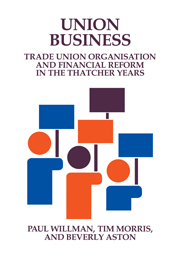Book contents
- Frontmatter
- Contents
- Acknowledgements
- 1 Introduction: unions in the 1980s
- 2 The financial status of British trade unions 1950–1989
- 3 Financial differences between unions
- 4 The role of financial matters in union organisation
- 5 The politics of union finaces
- 6 Union size, growth, and financial performance
- 7 Strike activity and union finances
- 8 The National Union of Mineworkers: strikes and financial disaster
- 9 The GMB: merger and financial reform
- 10 The Amalgamated Engineering Union: back from the brink
- 11 The Banking, Insurance and Finance Union: competitive unionism and financial survival
- 12 The Electrical, Electronic, Telecommunications and Plumbing Trade Union: accountability and financial control
- 13 Conclusions: union business and business unionism
- Appendix 1 Research methods
- Appendix 2 Regression results
- Appendix 3 Questions for finance officers
- Appendix 4 Questions for General Secretaries
- Appendix 5 Questionnaire: trade union finances
- Appendix 6 The number of trade unions
- Notes
- References
- Subject index
- Index of trade unions
- Author index
7 - Strike activity and union finances
Published online by Cambridge University Press: 11 March 2010
- Frontmatter
- Contents
- Acknowledgements
- 1 Introduction: unions in the 1980s
- 2 The financial status of British trade unions 1950–1989
- 3 Financial differences between unions
- 4 The role of financial matters in union organisation
- 5 The politics of union finaces
- 6 Union size, growth, and financial performance
- 7 Strike activity and union finances
- 8 The National Union of Mineworkers: strikes and financial disaster
- 9 The GMB: merger and financial reform
- 10 The Amalgamated Engineering Union: back from the brink
- 11 The Banking, Insurance and Finance Union: competitive unionism and financial survival
- 12 The Electrical, Electronic, Telecommunications and Plumbing Trade Union: accountability and financial control
- 13 Conclusions: union business and business unionism
- Appendix 1 Research methods
- Appendix 2 Regression results
- Appendix 3 Questions for finance officers
- Appendix 4 Questions for General Secretaries
- Appendix 5 Questionnaire: trade union finances
- Appendix 6 The number of trade unions
- Notes
- References
- Subject index
- Index of trade unions
- Author index
Summary
Introduction
Strikes continue to puzzle economists in part because they are, ex post, often inefficient for both parties concerned, particularly for union members who typically cannot shift their consumption patterns over time in the way that employers can shift production schedules. Whereas, overall, the costs of strikes for employers appear to be low, those for union members may be high (Hirsch and Addison, 1986: 76–8, Gennard, 1982).
Few economic models of strike activity explicitly consider the institutional interests of the union and the impact of strike activity on union organisation. Several models simply posit profit-maximising behaviour by firms confronted by non-rational behaviour from union members: the strike acts to bring member expectations in line with market pressure. These which do include a role for union leaders see them either as passive or narrowly self interested. Ashenfelter and Johnson (1969) assume no independent leader interest; they simply act as rational agents for irrational principals, going along with the strike simply to avoid challenge to their tenure. In other models, such as Swint and Nelson (1978, 1980), they pursue personal interests, again subject to some minimum gain from the strike below which they lose office. The institutional interests of the union and the organisational effects of strikes are otherwise excluded.
The proposition that unions as institutions may actually benefit from strike activity is of some interest. Both on logical and empirical grounds we might not expect it. Looked at financially, strikes involve an interruption to revenue and, possibly, higher organisational costs. Employer subsidies are likely to be withdrawn and the union must rely on its own reserves. For many unions, such reserves would be quickly exhausted.
- Type
- Chapter
- Information
- Union BusinessTrade Union Organisation and Financial Reform in the Thatcher Years, pp. 101 - 120Publisher: Cambridge University PressPrint publication year: 1993



